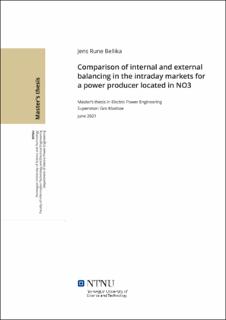| dc.contributor.advisor | Klaeboe, Gro | |
| dc.contributor.author | Bellika, Jens Rune | |
| dc.date.accessioned | 2021-10-07T17:22:32Z | |
| dc.date.available | 2021-10-07T17:22:32Z | |
| dc.date.issued | 2021 | |
| dc.identifier | no.ntnu:inspera:79786156:46871407 | |
| dc.identifier.uri | https://hdl.handle.net/11250/2788516 | |
| dc.description.abstract | Denne oppgaven undersøker potensialet knyttet til koordinert intradag- shandel og hvordan en produsent med en portefølje bestående av fleks- ible og momentane produksjonsenheter kan bruke intradagsmarkedet til å håndtere ubalanser. Studien er motivert av nylige oppdagelser i litterat- uren, som viser at det er mulig å generere meravkastning ved å koordinere intradagshandelen.
En bud modell med rullerende tidshorisont for hver time av intradags- markedet er blitt utviklet. En kraftprodusent med en portefølje bestående av fleksible og momentane produksjonsenheter bruker bud modellen for å maksimere inntektene fra intradagsmarkedet samtidig som ubalanser blir håndtert. Bud modellen bruker den ekte intradags-ordreboken i hver time av intradagsmarkedet. Modellen er bygd som et deterministisk optimering- sproblem som må bli løst for hver time av den rullerende tidshorisonten. Et base-case scenario der hver enhet dekker sin egen ubalanse er etablert og sammenlignet med et scenario der ubalansene blir håndtert på portefølje basis.
Et studie er utført på en kraftprodusent i prisområdet NO3 med en porte- følje bestående av vannkraft og elvekraft. Resultatet er overførbart til andre produksjonsenheter som feks. vindkraft. Resultatet viser en meravkastning ved å skifte til koordinert intradagshandel for perioden som er blitt testet. Hovedgrunnen til et bedre resultat med koordinert intradagshandel er fun- net til å kunne komme fra intradags-flaskehalser i overføringsnettet til og fra prisområdet NO3, og det faktum at den deterministiske modellen vil gi et best-case resultat. For å gjøre resultatet enda mer realistisk burde mar- ginalkostnaden for produksjonen til vannkraftverket bli representert bedre i modellen. | |
| dc.description.abstract | This master thesis investigates the potential related to a coordinated intra- day bidding approach and handling of imbalances for a producer with a portfolio of intermittent and flexible production units in a pay-as-bid in- traday market. The study is motivated by findings in recent literature that have found a potential profit from clearing imbalances with a coordinated intraday bidding approach.
An intraday bidding model with a rolling horizon approach for each stage of the intraday market are developed. A power producer with a portfolio of intermittent and flexible production units uses the bid model to maxim- ize revenues from intraday trading while clearing imbalances. The intraday modelling uses the real-time order book in each stage. The model is built as a deterministic optimization problem that has to be solved for each stage of the rolling horizon. A base-case scenario with plant-wise imbalance clear- ing are obtained and compared against a case with coordinated intraday bidding approach.
A case study is performed for a power producer located in the price area NO3 with a portfolio of reservoir and run-of-river hydropower. The result is transferable to other portfolios including wind power. There are found a profit from shifting to a coordinated intraday bidding approach for the period modelled. The reasons for a better result with a coordinated ap- proach is found to be reduced initial intraday transmission capacities for the period and the fact that the deterministic model will give a best-case result. A better representation of the marginal cost of production for the reservoir hydropower plant has been identified as an important improve- ment to make the results more reliable. | |
| dc.language | eng | |
| dc.publisher | NTNU | |
| dc.title | Comparison of internal and external balancing in the intraday markets for a power producer located in NO3 | |
| dc.type | Master thesis | |
